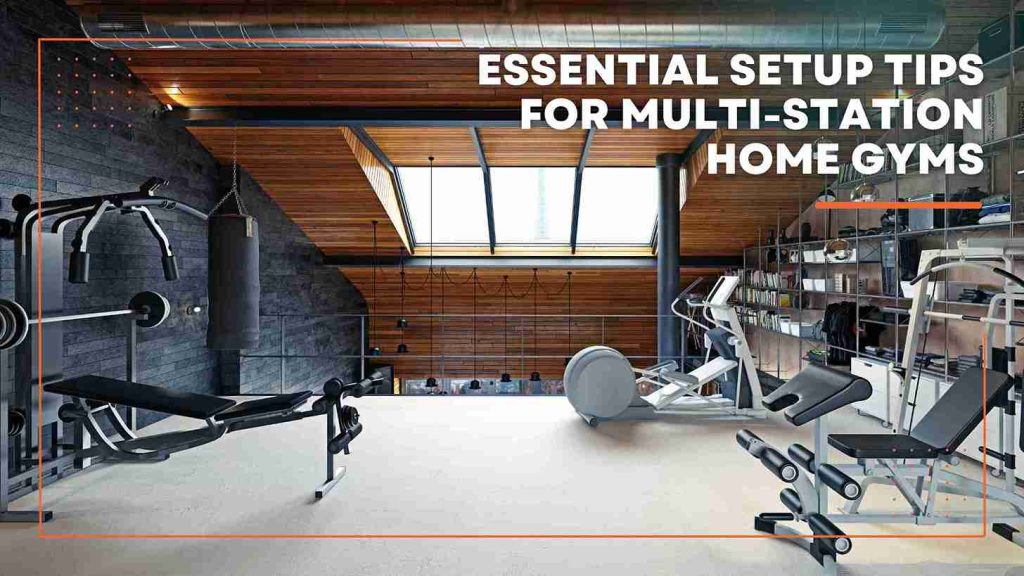Creating a home gym with multiple workout stations is a game-changer for your fitness journey. A well-planned home multi-gym setup brings the variety and functionality of a commercial gym right into your garage, basement, or spare room. But with greater versatility comes greater complexity—from layout planning to safe installation.
Multi-station home gyms can include everything from cable machines and leg presses to pull-up bars and resistance stacks. Assembling and organizing these components correctly ensures you get the most from your space and your equipment. This article walks you through essential setup tips, helping you avoid common mistakes while maximizing safety, convenience, and effectiveness.
Planning Your Multi-Station Layout
Before any equipment enters your space, proper planning is key. A rushed or unorganized layout can lead to cramped movement, inefficient workouts, or even safety hazards. Whether you’re working with a large basement or a modest garage, layout decisions will directly impact your results and experience.
1. Measure Your Space
Start by taking precise measurements of your room or garage. Consider ceiling height, floor area, and any obstructions like water heaters, support columns, or wall outlets. Some machines—like lat pulldown stations or Smith machines—require extra height or clearance when in use.
Leave at least 24 to 36 inches of clearance around each station to allow for safe movement and access to weights or attachments. If you’re doing a garage gym installation, account for your garage door clearance and seasonal storage needs.
2. Map Out Zones by Function
Divide your gym into functional areas such as:
- Strength training zone for squat racks, benches, and cable machines
- Cardio area for treadmills or bikes
- Mobility and stretching corner with mats or foam rollers
By segmenting the space this way, you create a logical flow that mirrors a commercial gym—making it easier to move between exercises and stay focused.
3. Choose Compact or Multi-Use Equipment
If you’re tight on space, invest in machines that combine multiple functions. A modern home multi-gym setup might include a single station with lat pulldown, chest press, leg curl, and cable crossover features—all in one frame.
Also, consider wall-mounted racks or foldable benches to maximize floor space when not in use.
4. Optimize for Power and Lighting
Ensure that your room has adequate electrical outlets if you’re using powered machines or smart fitness devices. Lighting also matters—a well-lit gym boosts energy and motivation. Use overhead LED lighting or strategically placed task lights to brighten up dark corners.
Equipment Safety Guidelines
Safety is the cornerstone of any home gym setup. From fitness station assembly to everyday use, taking the right precautions can prevent injury and prolong the life of your equipment.
1. Read All Manufacturer Instructions
Each machine has unique assembly requirements and safety warnings. Follow every step closely, using only the hardware and tools specified. Missing a bolt or improperly aligning a weight track can lead to equipment failure during a workout.
When assembling multi-station units, double-check that each pulley, weight stack, and adjustment pin is functioning properly before use.
2. Anchor Where Needed
Heavier equipment—such as squat racks or cable towers—should be anchored to the floor or wall, especially if they’re tall or top-heavy. In a garage gym installation, use concrete anchors or heavy-duty bolts that can handle dynamic weight loads.
Anchoring prevents tipping and shifting during intense workouts like pull-ups, deadlifts, or resistance band training.
3. Use Floor Protection
Install heavy-duty rubber mats or interlocking foam tiles beneath your machines. This protects your floor from damage and reduces vibrations during use. It also prevents machines from sliding or scratching the surface.
For concrete garage floors, rubber flooring also offers extra insulation during colder months.
4. Inspect Equipment Regularly
After your fitness station assembly, get into the habit of checking bolts, cables, and moving parts every few weeks. Look for signs of wear on handles, fraying cables, or loose components.
Lubricate moving parts like guide rods and pulleys periodically to keep everything running smoothly and quietly.
5. Keep the Area Clutter-Free
Always return weights, bars, and attachments to their racks or designated holders after use. Tripping hazards are common in home gyms—especially when space is limited. Consider labeling shelves or drawers to make organizing easier.
Professional Installation Advantages
While DIY is tempting, complex home multi-gym setup often benefits from professional help. With multiple machines, moving parts, and precision alignment required, hiring an expert can save time, stress, and even prevent injury.
1. Faster and More Reliable Setup
Professional installers are experienced with a wide variety of brands and machines. They know how to identify issues before they become problems and can usually complete installations in a fraction of the time it would take a first-timer.
If you’ve ever searched for “fitness station assembly near me,” you’ve likely seen companies that specialize in just this type of service.
2. Avoiding Costly Mistakes
Improper assembly can lead to damaged equipment, safety risks, or costly rework. For example, a slightly misaligned pulley can ruin the cable mechanism over time. Professionals have the tools and expertise to ensure your setup is both safe and functional from day one.
3. Wall and Floor Assessments
If your setup involves wall-mounted equipment or anchoring into concrete, a pro can assess your structure and install anchors correctly without damaging plumbing, electrical lines, or studs. This is particularly important during garage gym installation, where the surfaces and materials are often different from interior walls.
4. Post-Setup Testing and Calibration
A good installer doesn’t just build the equipment—they test it, level it, and show you how it works. This helps ensure that all components operate as intended, giving you peace of mind and a hassle-free workout experience.
Final Thoughts
A well-designed and properly installed home multi-gym setup can turn your spare room or garage into a powerful personal fitness center. But the key to success lies in careful planning, attention to safety, and knowing when to bring in professional support.From organizing zones to anchoring machines and ensuring correct assembly, every step contributes to a safer and more effective workout environment. Whether you’re handling fitness station assembly yourself or working with pros for a seamless garage gym installation, these tips will help you get the most from your investment—and your workouts.



